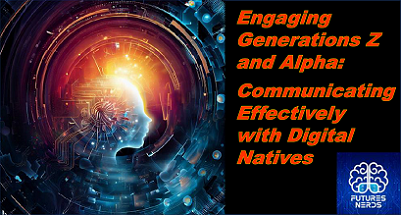[Editor’s Note: The Army’s Mad Scientist Laboratory is pleased to feature today’s post by the United States Army War College (USAWC) Team Future Nerds, excerpted from their final report entitled The Rise of the Digital Native: How the Next Generation of Analysts and Technology are Changing the Intelligence Landscape. This report was a group research project for Team Future Nerds’ Master of Strategic Studies degree. This research project occurred for approximately four months, from January 2023 through April 2023, and answered the following questions posed by LTG Laura A. Potter, Deputy Chief of Staff G2, Headquarters, Department of the Army:
How do 18-22-year-old intelligence analysts likely consume, synthesize, and communicate information today?
How is information consumption likely to evolve in ways that will change end-user information consumption habits between now and 2040?
Team Future Nerds consisted of the following diverse and well-rounded military professionals from the United States Army: COL Derek Baird (Field Artillery), COL Nora Flott (Military Intelligence), LTC(P) Tyler Standish (Military Intelligence), LTC(P) Brandon VanOrden (Military Intelligence), and LTC James Esquivel (Civil Affairs).
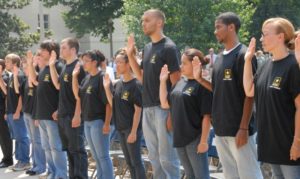 Today’s post excerpts LTC Esquivel’s informative primer addressing how Generations Z and Alpha (Gen-Z and Gen-A, respectively) — digital natives — consume and share information. As the U.S. Army wrestles with how best to solve its ongoing Accessions Crisis, LTC Esquivel’s piece is essential in understanding how to effectively package, share, and most importantly, communicate the Army Story so that it resonates with our Nation’s youth and encourages them to sign up for National Service. Of equal importance is integrating these findings into
Today’s post excerpts LTC Esquivel’s informative primer addressing how Generations Z and Alpha (Gen-Z and Gen-A, respectively) — digital natives — consume and share information. As the U.S. Army wrestles with how best to solve its ongoing Accessions Crisis, LTC Esquivel’s piece is essential in understanding how to effectively package, share, and most importantly, communicate the Army Story so that it resonates with our Nation’s youth and encourages them to sign up for National Service. Of equal importance is integrating these findings into  our Professional Military Education, tailoring how our Schools and Centers of Excellence educate and train our incoming cohorts of Soldiers, build future Leaders into effective collaborators, and maximize the Army Team’s potential — Read on!]
our Professional Military Education, tailoring how our Schools and Centers of Excellence educate and train our incoming cohorts of Soldiers, build future Leaders into effective collaborators, and maximize the Army Team’s potential — Read on!]
Executive Summary
Due to the democratization of smart phones and technology advances, it is very likely (80-95%) that Gen-Z and Gen-A will continue to prefer quick, immersive, and visually-aided technologies that provide them information and knowledge of how to accomplish a task with expediency through 2040. Despite the technological comfort and proficiency that Gen-Z and Gen-A  exercise, it will remain crucial for older generations to understand how and why these digital natives1 prefer to communicate in social and professional environments. This will provide a better exchange for collaboration between generations throughout the Intelligence Process in 2035-2040.
exercise, it will remain crucial for older generations to understand how and why these digital natives1 prefer to communicate in social and professional environments. This will provide a better exchange for collaboration between generations throughout the Intelligence Process in 2035-2040.
Discussion
Gen-A is currently the youngest generation, born completely in the 21st century between 2010-20242. This young generation will almost certainly grow up as true 100% digital natives3, immersed in technology, smartphones, and social media that was created before their birth. Gen-A and society are actively discovering and learning about their personal preferences and responses to a technological environmental habitat. The current data suggests that Gen-A embraces multiple forms of technology from smart phones, computer gaming, and computer-based visual/experiential-driven education. In particular, Gen-A has shown a proclivity for educational and game playing experiences that require  creativity, teamwork, and collaboration. A unique research finding in the post-COVID environment suggest that Gen-A is embracing the post-pandemic lockdown and showing an increasing interest for in-person activities such as physical play time with friends and attending cinema in person vice watching online. This data suggests that while Gen-A does have access to digital communication platforms, they are showing an increased interest in personalized face-to-face communication in the post-COVID environment.
creativity, teamwork, and collaboration. A unique research finding in the post-COVID environment suggest that Gen-A is embracing the post-pandemic lockdown and showing an increasing interest for in-person activities such as physical play time with friends and attending cinema in person vice watching online. This data suggests that while Gen-A does have access to digital communication platforms, they are showing an increased interest in personalized face-to-face communication in the post-COVID environment.
Gen-Z, born between the mid-1990s and mid-2000s, prefers concise communication that is visual, interactive, personalized, and relatable to their beliefs-values. These digital natives have evolved and mastered the ability of multitasking technology applications across multiple platforms, but frequently prefer the use of their smart phones. Growing up as digital natives, Gen-Z is accustomed to the availability and immediacy of information and will continue to expect this immediacy and flow into the future. Gen-Z shows a proclivity for visuals and images in their personal communication environment, 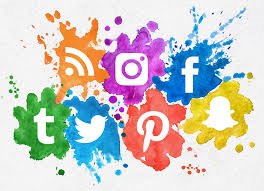 especially short burst text and short form videos. Research and marketing results show that Gen-Z spends up to five hours a day on varying social media and entertainment platforms absorbing visual and video media.
especially short burst text and short form videos. Research and marketing results show that Gen-Z spends up to five hours a day on varying social media and entertainment platforms absorbing visual and video media.
In regard to Gen-Z’s communication habits, texting is the preferred method of communication amongst friends and social groups which facilitates rapid, short text exchanges. One-on-one communication in the workplace is the preferred and more effective way to communicate with this generation. Gen-Z wants to be taken seriously and expects a personal interaction with their bosses and superiors when conducting work related matters. They prefer to communicate through SMS,  email, and social media when working on routine matters or activities, but expect their superiors to communicate directly when working on important or personal issues.
email, and social media when working on routine matters or activities, but expect their superiors to communicate directly when working on important or personal issues.
The use of technology is beneficial when communicating with Gen-Z , but it is also important to provide a personal touch in communication with Gen Z. Varying the ways in which feedback is given can also be effective, as Gen Z values feedback from others and wants leaders who listen to their ideas and show they value their opinions. Gen-Z uses informal communication methods such as chat and videos to quickly exchange ideas and contribute to  conversations in order to establish appreciation for their intuitive mode of communication. Finally, it is important to prioritize and value face-to-face communication with Gen-Z as they value honesty, authenticity, and transparency.
conversations in order to establish appreciation for their intuitive mode of communication. Finally, it is important to prioritize and value face-to-face communication with Gen-Z as they value honesty, authenticity, and transparency.
 Regarding current technological commonality between Gen-A and Gen-Z is the ubiquitous use of the social media application known as TikTok. This application is a video-sharing social media platform that is gaining massive popularity across Gen-A and Gen-Z age ranges. TikTok’s technological effectiveness is found in the form of short-video formats that capture the user’s attention at a personal preference level, relying on visually attractive-short form video footage ranging from 5-60 seconds. The app is convenient to use, and anyone with a smartphone can easily create and post content. TikTok utilizes a recommendation algorithm that is not reliant upon the building an individual’s network of shared recommendations.
Regarding current technological commonality between Gen-A and Gen-Z is the ubiquitous use of the social media application known as TikTok. This application is a video-sharing social media platform that is gaining massive popularity across Gen-A and Gen-Z age ranges. TikTok’s technological effectiveness is found in the form of short-video formats that capture the user’s attention at a personal preference level, relying on visually attractive-short form video footage ranging from 5-60 seconds. The app is convenient to use, and anyone with a smartphone can easily create and post content. TikTok utilizes a recommendation algorithm that is not reliant upon the building an individual’s network of shared recommendations.  This recommendation algorithm is proving to be highly effective and addictive, as witnessed by the continuous increase in the app’s use and popularity. Despite current concerns over national security and pending Federal legislation to ban TikTok, it is very likely (80-95%) that young people will continue using the platform to send political messages, coordinate social actions, and hang out in an online space largely free of older generations. Current research indicates that Gen-Z spends more than five hours per day on this platform.
This recommendation algorithm is proving to be highly effective and addictive, as witnessed by the continuous increase in the app’s use and popularity. Despite current concerns over national security and pending Federal legislation to ban TikTok, it is very likely (80-95%) that young people will continue using the platform to send political messages, coordinate social actions, and hang out in an online space largely free of older generations. Current research indicates that Gen-Z spends more than five hours per day on this platform.
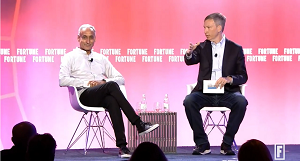
Prabhakar Raghavan, a Senior Vice President at Google, indicated in a Fortune Magazine online interview that approximately 40% of Gen-Z prefer to use platforms other than Google Search to discover information. The internal Google review indicates that the younger population, e.g., Gen-A and Gen-Z, favors platforms such as TikTok or Instagram to meet their information search requirements.
In a July 2022 NBC News interview, young Gen-Zs indicated that they prefer a visual platform that is easily accessible and provides a quick and informative associated video to their search query. One of the responses that was predominant in the interviews was, “It’s one thing to read about what to do in this area or how this product works, but it’s another thing to see it.”
A key finding in the interview with Prabhakar Raghavan reveals that today’s generations have more technical ability than ever before and prefer quick, immersive, and visually-aided technologies that provide them with timely information 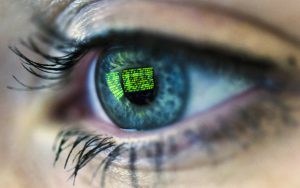 on how to accomplish tasks at hand. It is very likely (80-95%) that these findings hold true and are consistent in the years 2035-2040.
on how to accomplish tasks at hand. It is very likely (80-95%) that these findings hold true and are consistent in the years 2035-2040.
Analytic Confidence
The analytic confidence for this estimate is moderate. Sources were generally reliable and tended to corroborate one another but were mostly non-scientific in nature and methodology. Artificial Intelligence platforms were encouraged and utilized in the creation and research for this project, as an example, Perplexity, Bard, and Chat GPT. There were competing academic requirements for time, and the analyst worked alone and did not use a structured method. Furthermore, given the lengthy time frame of the estimate, this report is sensitive to change due to new information.
If you enjoyed this post, check out Team Future Nerds‘ complete The Rise of the Digital Native: How the Next Generation of Analysts and Technology are Changing the Intelligence Landscape final report.
… then review the following related Mad Scientist content:
Recruiting the All-Volunteer Force of the Future and The Inexorable Role of Demographics, by proclaimed Mad Scientist Caroline Duckworth
U.S. Demographics, 2020-2028: Serving Generations and Service Propensity
The Future of Talent and Soldiers and associated podcast, with MAJ Delaney Brown, CPT Jay Long, and 1LT Richard Kuzma
The Operational Environment (2021-2030): Great Power Competition, Crisis, and Conflict, along with its source document
Synchronizing Modernization across the Army and associated podcast, with GEN Gary M. Brito
The Secret Sauce of America’s Army and associated podcast, with GEN Paul E. Funk II (USA-Ret.)
Setting the Army for the Future (Parts II and III)
New Skills Required to Compete & Win in the Future Operational Environment
The Future of Learning: Personalized, Continuous, and Accelerated
The Future of Talent and Soldiers and associated podcast, with MAJ Delaney Brown, CPT Jay Long, and 1LT Richard Kuzma
The Trouble with Talent: Why We’re Struggling to Recruit and Retain Our Workforce by Sarah L. Sladek
Chatty Cathy, Open the Pod Bay Doors: An Interview with ChatGPT and associated podcast
The AI Study Buddy at the Army War College (Part 1) and associated podcast
>>>>REMINDER: AFGFR Vignette Writing Contest — Our Sister Service partners in the U.S. Air Force (USAF) are proud to present the Air Force Global Futures Report: Joint Functions in 2040, published by Headquarters Air Force A5/7 (aka Air Force Futures). This report is the USAF’s analogue to the U.S. Army Futures Command’s AFC Pamphlet 525-2, Future Operational Environment: Forging the Future in an Uncertain World 2035-2050.
The AFGFR highlights four future operating environments and major implications for the future force. To bring these operating environments to life, Army Mad Scientist is partnering with the Air Force Futures’ Foresight Team to conduct the AFGFR Vignette Writing Contest — based on the report’s four futures and the exploration of the Joint Functions. We are seeking vignettes with characters that make the future operating environments and associated 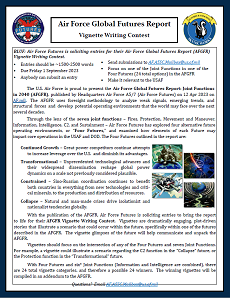 Joint Functions within come to life!
Joint Functions within come to life!
The AFGFR Vignette Writing Contest is open to all — anyone can submit an entry. Entries should be between 1500-2500 words in length, and are due NLT 01 September 2023 — next Friday!!! To learn more about the contest and how to submit your entry(ies), click >>>> here <<<< and read the contest flyer!
Disclaimer: The views expressed in this blog post do not necessarily reflect those of the U.S. Department of Defense, Department of the Army, Army Futures Command (AFC), or Training and Doctrine Command (TRADOC).
1 The Oxford English Dictionary defines digital native as a person born or brought up during the age of digital technology and therefore familiar with computers and the internet from an early age
2 Depending on the source, the age bracket year of birth for Gen-A will vary from 2010 to 2012 and end from 2024-2025
3 Per the Oxford English Dictionary – a person born or brought up during the age of digital technology and therefore familiar with computers and the internet from an early age

